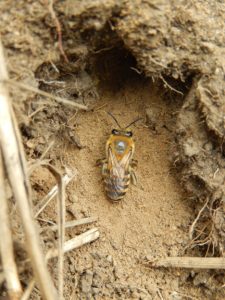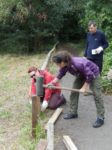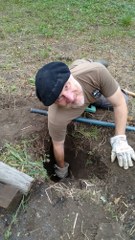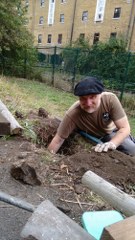
It’s not every day a new species turns up, but here’s one. The Ivy Bee, Colletes hederae, was only described in 1993. It’s a European plasterer bee that likes warm dry sandy soil, and provisions its nest with Ivy pollen (Hedera, if you didn’t get it). The eggs hatch into larvae, which eat the pollen and overwinter in the burrow. The adults emerge the following September; the females dig burrows and energetically collect the pollen which is only available then, while the males laze about, fight, grab females and mate, boast about the women they’ve laid, and drive fast cars. Well, I lied about the last two items, obviously. In 2001 the species arrived in Dorset, and it has since spread across southern England, for instance finding good sandy sites in Oxfordshire. Now in 2016 it has come to Chiswick.
We’re happy to report that the bare sandy ground on the steep south-facing bank has turned out to be ideal for this rather special bee. The young foxes seem to lark about and run up and down the bank every morning, which keeps the vegetation very low with plenty of bare soil. This is just what mason and plasterer bees like, and the ground is full of nest holes.
My thanks to Mick Massie for bringing this species to my attention.


While we weren’t being diverted to photograph the Ivy Bee, we spent the day sorting out the low fence along the ramp path. Here’s Netty and the team whacking a post. I did quite a lot of digging and a fair bit of sawing.


